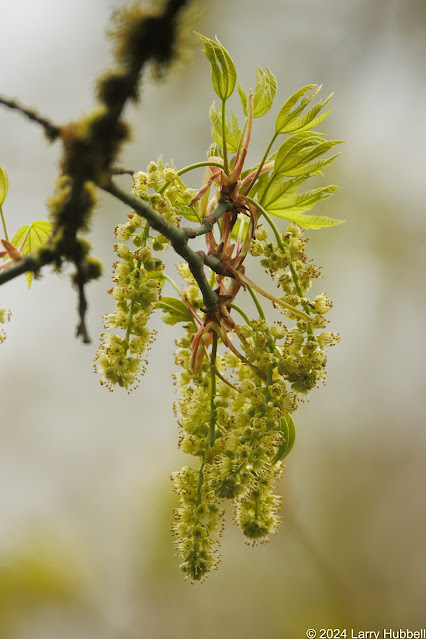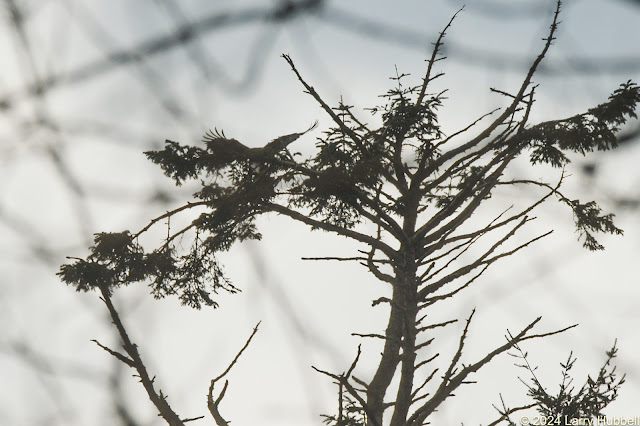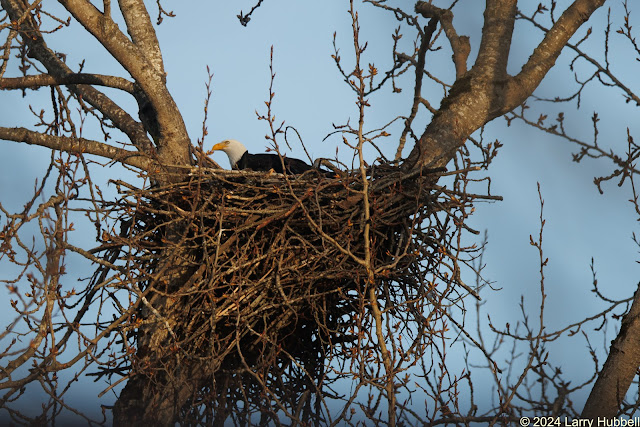Early in March, this pair of Belted Kingfishers circled over Union Bay near the west end of Marsh Island. They were circling while making their distinctive rattling calls.
The male, having only one blue belt across the chest, was slightly behind the female. Even though they were almost in a parallel formation, it was obvious that he was pursuing her. His quest appeared to be passing on his DNA asap.
The female stayed just out of reach. I suspect she was looking for a safe and functional nest site before she would allow the initiation of eggs.
They were moving so fast that it was difficult to see their detailed markings. Later, when reviewing this photo I was amazed to notice the pale brown coloring on the underside of the tips of the male's flight feathers.
My typical Kingfisher sighting usually starts with hearing their noisy, rattle. Often, I look up just in time to see an empty branch bouncing above the water. If I am lucky, I notice a blue streak disappearing in the distance. This is almost always accompanied by the fading sound of the bird's obviously-irritated chattering.
It is almost like the Kingfishers are laughing at me. I imagine them saying, "You should be embarrassed, standing there with your camera in hand, looking for birds, and yet I, who was focused on fishing, saw you first."
(My friend Dave Galvin tipped me off to this ancient story about the Kingfisher and its laughing at foolish humans.)
This photo is of a female seen in Montlake at the end of March. The rufous coloring on her body indicates she is a female. (By the way, you might want to compare the Kingfisher's headdress in this photo with the previous photo when they were in flight.)
The unusual angle of this photo shows her incredibly short legs. With Belted Kingfishers it almost seems like their feet are attached directly to their bodies. Their tiny little legs become even more amazing when you consider how they use them.
Kingfishers dig a horizontal burrow, potentially as deep as six feet, into a bank. At the far end of the burrow, they create a nesting chamber, which is slightly elevated relative to the entry. The chamber is roughly the size of a football. I have read that the burrow will have two furrows along each side which indicate how they use their feet to tunnel to their potential nest site. AllAboutBirds says the males usually do the majority of the digging, I suspect they are motivated by their DNA quest and their related desire to be in the good graces of the female.
Personally, someday, I hope to find a Belted Kingfisher nest site, around Union Bay. I understand they prefer vertical banks, unencumbered by concrete, tree roots, or rocks, with soft soil or gravel that they can easily excavate, and typically their nests are near water. So far, the best candidate locations I have seen are the temporary piles of excavated dirt along the 520 freeway project.
Last week, I was surprised to find Kingfishers at this empty construction site in the middle of Montlake. During the last month, an older home was torn down while the site was being prepared for a new foundation and the building of a new home. The site is at least a quarter mile from water in every direction. My first thought was what is a Kingfisher doing so far from water. But after a moment or two, the obvious conclusion occurred to me. They were looking for a nest site. If you turn up the volume, while listening to this video, you can hear the Kingfishers chattering as they circle and chase around the property.
Initially, I saw mostly the male but fairly quickly I noticed he was often chasing and "speaking" to a female.
She sometimes answered his calls.
Whenever it seemed like the male might be getting too close, she would promptly turn and bounce to the next nearby perch.
It looked like she was inspecting the site too.
She also seemed to be listening and responding to the male.
No matter, whether she was on a nearby rooftop or...
...the next-door chimney, she always seemed to stay just out of his reach, while also maintaining an excellent view of the excavation.
I suspect she was waiting to see if he would or could dig an adequate nest.
I was struck with conflicting emotions. I was curious to see if they would try nesting, which I had never seen before. I was also saddened by the thought that, even if they did start digging, the heavy equipment and the construction effort would likely destroy their attempt well before they could lay any eggs.
In another sense, the fact that they found this potential site, so far from water, was also encouraging. It told me, that Kingfishers are more flexible and adaptable than one might expect.
This is particularly reassuring for myself and other Friends of Arboretum Creek. We have been working to supply additional clean water and more native plants to the riparian area along the stream. We also hope to help reconnect the creek with Union Bay. This will require removing the creek from a pipe that runs under Lake Washington Blvd and restoring it to the surface. This will allow fish to swim into the creek for the first time in nearly one hundred years.
My friend Elaine Chuang and I have been monitoring the birds along Arboretum Creek for a couple of years. So far, we have never seen any of the typical fish-eating birds utilizing the stream.
Currently, Belted Kingfishers, Pied-billed Grebes, Great Blue Herons and others are quite plentiful just beyond the mouth of the creek in Duck Bay, which is full of fish. This month's experience with the Kingfishers in Montlake reinforces that when the fish re-enter Arboretum Creek the Kingfishers will be watching. Since they have noticed a potential nesting site a quarter mile from where they normally fish, I have no doubt, that when they pass over Arboretum Creek they are also watching for fish. I expect they will be the first avian indicator that fish are once again living in the stream. Someday, after the fish return, maybe Arboretum Creek will be more appropriately called, Kingfisher Creek.
This week, the construction forms are being built to create the foundation for the new home that will be built in Montlake. It has been about a week since I last heard or saw the Kingfishers circling the property. I suspect they have decided that even though the excavated soil is appealing, all the ongoing human activity makes the site a poor choice for nesting.
Here is my last video of the Kingfishers near the Montlake property. I believe the female left first and the male, chattering loudly, followed her. The good news is they headed towards Union Bay and Marsh Island when they left. I wish them well and hope they find the perfect nest site and raise a whole new generation of Belted Kingfishers on Union Bay!
Have a great day on Union Bay...where nature lives in the city and Black Birders are welcome!
Sincerely,
Larry
Each of us, who breathes the air, drinks water, and eats food should be helping to protect our environment. Local efforts are most effective and sustainable. Native plants and trees encourage the largest diversity of lifeforms because of their long intertwined history with our local environment and the local native creatures. Even the microbes in the soil are native to each local landscape.
I hope we can inspire ourselves, our neighbors, and local businesses to respect native flora and support native wildlife at every opportunity. I have learned that our most logical approach to native trees and plants (in order of priority) should be to:
1) Learn and leave established native flora undisturbed.
2) Remove invasive species and then wait to see if native plants begin to grow without assistance. (When native plants start on their own, then these plants or trees are likely the most appropriate flora for the habitat.)
3) Scatter seeds from nearby native plants in a similar habitat.
4) If you feel you must add a new plant then select a native plant while considering how the plant fits with the specific habitat and understanding the plant's logical place in the normal succession of native plants.
***************
Keystone native plants are an important new idea. Douglas Tallamy, in the book "Nature's Best Hope ", explains that caterpillars supply more energy to birds, particularly young birds in their nests, than any other plant eater. He also mentions that 14% of our native plants, i.e. Keystone Plants, provide food for 90% of our caterpillars. This unique subset of native plants and trees enables critical moths, butterflies, and caterpillars that in turn provide food for the great majority of birds, especially during the breeding season.
Note: Flowering plants and trees, i.e. those pollinated by bees, are also included as Keystone Plants.
This video explains the native keystone plants very nicely:
https://www.youtube.com/watch?v=O5cXccWx030
The Top Keystone Genera in our ecoregion i.e. Plants and trees you might want in your yard:
Click Here
Additional content available here:
https://wos.org/wos-wp/wp-content/uploads/2022/10/Native-Plant-Resources-10-7-22.pdf
******************
In the area below, I am displaying at least one photo with each post to help challenge us to know the difference between native and non-native lifeforms.
Is this a native flower? If so, which one is it?
Scroll down for the answer.
******************
Big Leaf Maple: Yes. This is the flower of the native Big Leaf Maple tree, which is a keystone species in terms of benefit to butterflies, moths, caterpillars and birds. Plus, it provides oxygen, holds carbon, provides nest sites, its wide moss-covered branches provide places for Cooper's Hawks to feed, it provides a substrate for licorice ferns, its hard wood can be used to make spoons, paddles, bowls, and other useful items. Finally, it can also be a food source.
Click Here to learn more.
*****************
The Email Challenge:
Over the years, I have had many readers tell me that Google is no longer sending them email announcements. As of 2021, Google has discontinued the service.
In response, I have set up my own email list. With each post, I will manually send out an announcement. If you would like to be added to my personal email list please send me an email requesting to be added. Something like:
Larry, Please add me to your personal email list.
My email address is:
LDHubbell@comcast.net
Thank you!
*******************
The Comment Challenge:
Another common issue is losing your input while attempting to leave a comment on this blog. Often everything functions fine, however, sometimes people are unable to make it past the robot-detection challenge or maybe it is the lack of a Google account. I am uncertain about the precise issue. Sadly, a person can lose their comment with no recovery recourse.
Bottom Line:
If you write a long comment, please, copy it before hitting enter. Then, if the comment function fails to record your information, you can send the comment directly to me using email.
My email address is:
LDHubbell@comcast.net
Sincerely,Larry





























































